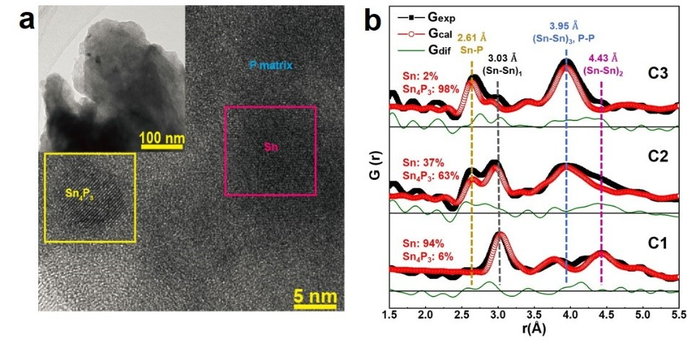Sodium-ion batteries are a stimulating substitute for post-lithium energy storage even though their high-efficiency anode materials are still limited.
 (a) Composite of Sn/Sn4P3 nanodomains embedded in amorphous P matrix. (b) Quantitative analysis by PDF. (Image Credit: Haijun Yu, Beijing University of Technology).
(a) Composite of Sn/Sn4P3 nanodomains embedded in amorphous P matrix. (b) Quantitative analysis by PDF. (Image Credit: Haijun Yu, Beijing University of Technology).
Phosphorus-based materials frequently experience poor performance retentions due to low conductivity and huge volume expansion although they enable high-capacity anodes for sodium-ion batteries.
Researches based at the Beijing University of Technology aim to create a cost-effective sodium-ion battery, and for this, they have synthesized a series of P-/Sn-based composites that work as high-stability and high-capacity anode materials, enabling a full battery capable of a capacity retention of 97.7% after 50 cycles.
Haijun Yu, professor in the Institute of Advanced Battery Materials and Devices, Faculty of Materials and Manufacturing at Beijing University of Technology, heads the research team that focuses on efficiently customizing the architectures of components in the P-/Sn-based composites for greater stability by the facile and cost-effective one-step ball milling. The researchers presented their approach in the October 1st issue of the journal Energy Material Advances.
Considering the high abundance and low cost of sodium resources, sodium-ion batteries are expected to be a vital alternative to the extensively used lithium-ion batteries.
Haijun Yu, Study Corresponding Author and Professor, Beijing University of Technology
Yu further stated that high-capacity anode materials, e.g., phosphorus, have gained extensive recognition for their low discharge voltages, low costs and high theoretical capacities.
However, phosphorus often suffers from large volume expansions, leading to many problems, such as structural collapse, particle pulverization, and thus rapid performance decay. It is thus essential to buffer these problems by appropriately alloying with other elements such as tin and constructing well-designed microstructures.
Haijun Yu, Study Corresponding Author and Professor, Beijing University of Technology
“The development of low volume expansion and long cycle stable phosphorus-based composite anode materials has become an urgent issue. It is of great significance to develop cost-effective and scalable approaches to elegantly adjust the microstructures of composites to eliminate their drawbacks,” Yu added.
In their paper, the researchers have synthesized a series of P-/Sn-based composites by the facile and cost-effective one-step ball milling. They realized an optimal structure made up of crystalline nanodomains such as Sn4P3, and Sn embedded and detached in an amorphous phosphorus matrix.
This architecture hampers the aggregation of metallic Sn-based particles and enhances the conductivity of amorphous phosphorus, thus upgrading the competence of electrochemical reactions.
Furthermore, the volume expansion-induced particle collapse is suppressed due to the small size of crystalline domains and the amorphous nature of phosphorus, thus supporting the material with high stability.
Such highly disordered composite anode materials also find it challenging to gain local structure information of varied microstructures by average means, that is, examining macroscopic amounts of materials instead of testing a very limited region.
As a hardcore quantitative technique, pair distribution function (PDF) is freshly introduced here to elucidate their structures incorporated with other techniques, signifying the formation and ratios of Sn4P3 and Sn crystalline domains embedded within the amorphous matrix.
As a powerful characterization technique, PDF not only provides local structure information for complex systems but can also calculate the components in ordered or even disordered materials. Li and Huang highlighted that the researchers invented new approaches, including the utilization of atom PDF for the very first time, to quantitatively examine the proportion and structure of SnPx crystalline domains.
Baixu Chen, the first author, states that sodium-ion batteries are expected to be a significant alternative to the widely used lithium-ion batteries by taking into consideration the low cost and high abundance of sodium resources. In his survey of electrode materials for sodium-ion batteries, tin and phosphorus were selected because of their low costs, low discharge voltages and high theoretical capacities.
The study sheds light on the rational design and concrete identification of P-/Sn-based amorphous-dominant composite materials for sodium-ion batteries.
Baixu Chen, Study First Author, Beijing University of Technology
The team emphasized that the research adjusts and recognizes the components and microstructures of P-/Sn-based anode materials, providing an understanding of the design of high-performance anode materials for sodium-ion batteries.
The contributors of this research include Baixu Chen, Yubo Yang, Xu Zhang, Jaffer Saddique and Haijun Yu at Beijing University of Technology; and Aibing Chen at Hebei University of Science and Technology; Mingxue Tang, Center for High Pressure Science & Technology Advanced Research.
This research was supported by the Beijing Natural Science Foundation (JQ19003), National Natural Science Foundation of China (21975006, 21875007, 22075007, U19A2018, and 51802009), the National Key R&D Program of China (2018YFB0104302), and the Beijing Youth Scholar (PXM2021_014204_000023).
Journal Reference:
Chen, B., et al. (2021) Sodium-Ion Battery Anode Construction with SnPx Crystal Domain in Amorphous Phosphorus Matrix. Energy Material Advances. doi.org/10.34133/2021/9795825.